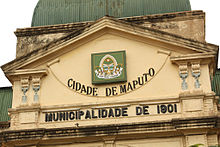Central Market of Maputo
The Mercado Central de Maputo , in English "Maputo Central Market", is a market hall in the center of the Mozambican capital Maputo . In addition to the central location - directly on Avenida 25 de Setembro - and the high customer frequency, the market is particularly known for its building from the turn of the century around 1900. The market is popularly known as “Bazar da Baixa” (downtown bazaar).
history
By 1900, the capital of Portuguese East Africa (Mozambique), Lourenço Marques , was considerably smaller. The colonial administration decided to further urbanize the coastal zone close to the city and decided to erect a new market building in front of the former gates of the city, not far from the port facilities . The Portuguese company David & Carvalho, who commissioned the architect Carlos Mendes (1869–1922) with the design, received the order. The building was opened on September 30, 1903 as “Mercado Municipal Vasco da Gama” with reference to the Portuguese navigator Vasco da Gama .
When designing the large market building, Mendes allegedly based himself on the Hamburg Alster pavilion at the time . A large entrance portal with a small tower forms the central access to a large, covered market hall. In addition to the portal, the facade is characterized by many classicistic elements, small arched niches provide space for permanent sales facilities. To the north, Mendes designed the market open with an adjoining open space.
Over the decades, the market has developed into the city's most important local trading point. In the course of Mozambique's independence in 1975, the market lost the nickname Vasco da Gama . The importance of the market also declined due to the economic effects of the civil war and the economic collapse as a result of massive short-term unemployment as well as capital flight and emigration from the People's Republic of Mozambique . This changed with the end of the civil war in 1992 and the economic reorientation of the country.
On July 22, 2005, a large part of the market building burned down completely at night. Due to financial bottlenecks and economic difficulties in Mozambique, the makeshift repair took more than two years. In the run-up to the local election campaign in 2013 , the Mayor of Maputo, David Simango , had the building completely renovated as part of a campaign to renovate many marketplaces, after this had been announced for several years. In the course of the construction work, which was completed in June 2014, several rows of kiosks are replacing the previously existing open space. Furthermore, since then there have been 534 sales opportunities for individuals in the market hall, previously there were 518.
Since 2011 the building has been in the preselection for a list of monuments for the city of Maputo. It is listed under the number 31703 in the Portuguese monument database Sistema de Informação para o Património Arquitectónico , which also includes works by former Portuguese colonies.
Web links
Individual evidence
- ↑ a b c Elídio Alberto Muamine: Género, relações de poder e Mercado de trabalho: Estudo de caso das mulheres vendedoras no Mercado Central da Baixa da Cidade de Maputo . Maputo March 2013, p. 42 f . (Portuguese, saber.ac.mz [PDF] Bachelor in anthropology from the Departamento de Arqueologia e Antropologia na Universidade Eduardo Mondlane). saber.ac.mz ( Memento of the original from April 21, 2017 in the Internet Archive ) Info: The archive link was inserted automatically and has not yet been checked. Please check the original and archive link according to the instructions and then remove this notice.
- ^ Arquitecto Carlos Mendes (1869–1922). (No longer available online.) In: Correio do Vouga. December 17, 2011, formerly in the original ; Retrieved September 18, 2014 (Portuguese). ( Page no longer available , search in web archives ) Info: The link was automatically marked as defective. Please check the link according to the instructions and then remove this notice.
- ^ Mercado Municipal de Maputo. (No longer available online.) Club of Mozambique, September 5, 2013, archived from the original on September 23, 2015 ; accessed on September 18, 2014 (English). Info: The archive link was inserted automatically and has not yet been checked. Please check the original and archive link according to the instructions and then remove this notice.
- ↑ a b José Manuel Fernandes: Mercado Municipal Vasco da Gama (Atual Mercado Central). In: Patrimónia da Influência Portuguesa (HPIP). Fundação Calouste Gulbenkian, January 14, 2013, accessed September 18, 2014 (Portuguese).
- ↑ Joseph Hanlon: Mozambique. Revolution in the crossfire. Translation from English, edition southern afrika 21; Bonn 1986, pp. 65-67 ISBN 3-921614-25-2
- ↑ Incendio destrói parcialmente Mercado Central de Maputo. In: Moçambique para todos. Notícias Lusófonas, July 22, 2005, accessed September 18, 2014 (Portuguese).
- ^ Mercado Central do Município de Maputo. In: Moçambique para todos. September 4, 2007, Retrieved September 18, 2014 (Portuguese).
- ↑ Autárquicas 2013: Simango promete requalificar mercados da cidade de Maputo. In: A Verdade. November 14, 2013, accessed September 18, 2014 (Portuguese).
- ↑ Tiago Valoi: disponíveis fundos para reabilitação do Mercado Central de Maputo. In: O País. May 10, 2010, Retrieved September 18, 2014 (Portuguese).
- ^ Mercado Central com novo visual. In: Jornal Notícias. June 16, 2014. Retrieved September 18, 2014 (Portuguese).
- ↑ Tiagou Lourenço: Mercado Central de Maputo. In: Sistema de Informação para o Património Arquitectónico (SIPA). 2011, accessed September 18, 2014 (Portuguese).
Coordinates: 25 ° 58 ′ 14.9 ″ S , 32 ° 34 ′ 7.9 ″ E



